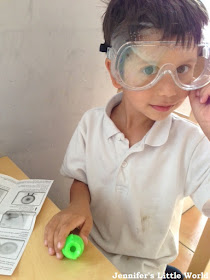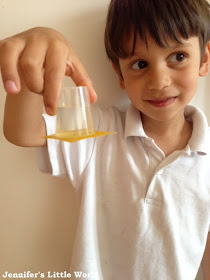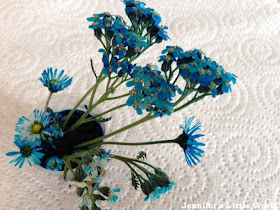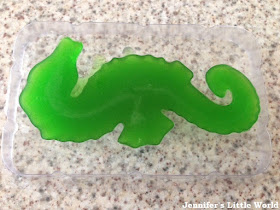We were sent two kits from the Science4you range. The first kit that we looked at was Science4you Water Science. The recommended age range is children aged 6 and older, Harry is 5 1/2. He is nowhere close to being able to do the experiments by himself, but we had a lot of fun doing them together. Mia was also around while we were working on this kit and she was pretty entertained by a lot of the experiments too, especially those involving bubbles!
The Water Science kit contains materials and instructions to carry out 27 experiments. The kit doesn't contain every single thing that you will need, although most of the materials are easily available from around the house. Some of the experiments can only be done once, and others can be done over and over again. The booklet included with each kit is very comprehensive, with detailed instructions and plenty of additional information to help explain the science behind the experiments.
I think that I was just as surprised as Harry when the first experiment worked! You just need to put some water into the beaker, place a piece of paper over the top and then quickly flip the beaker over. Harry was absolutely fascinated that the water stayed in the beaker when it was upside down, with just a piece of paper holding it in, and we had a lot of fun waving it about, placing it over each other's heads and so on, without spilling any.
Putting cut white flowers into dyed water and watching them change colour is a classic experiment, but we've not tried it before, and the results were pretty impressive. The flowers acquired a blue tinge within minutes, and the next day were beautifully blue. Another experiment that took a few hours to work was the water beads. I've seen these often used in sensory play for little ones but never actually used any myself. The tiny beads absorb water and turn into little jelly balls which are a lot of fun to play with and have been bouncing about the house ever since.
We also did experiments using plastic bottles, tubes, straws, bubbles, syringes and more. I will admit that I couldn't get all of them to work first time, which Harry fortunately accepted because of course I'm not a scientist. The instructions also include the scientific explanations for the experiment, it helps if you understand it a little bit yourself as they are quite complicated and I needed to try and explain it to Harry in a way that he could understand.
The second kit that we looked at was Science4you Slimy Factory Slippery Slugs. This kit has a recommended age range of 8 years and older. This wasn't a problem for us at all as we were doing the experiments together but we did scoot Mia out of the way as the experiments involved quite a bit more concentration, as well as substances that I wouldn't want a younger child to be playing with. Here are the contents of the kit:
Unfortunately there were a couple of bits missing from the kit, but I contacted the company and received replacements within a few days.
The Slimy Factory Slippery Slugs kit lets you carry out 17 experiments. Because this kit is aimed at slightly older children it is a little more complicated. For the first set of experiments you need to make Sodium Alginate and Calcium Chloride solutions. It's pretty basic, and just involves a bit of measuring and adding water, but to little ones it does feel like you are carrying out some real, scientific experiments.
You can use the Sodium Alginate in the diluted Calcium Chloride to make little blobs in a variety of different colours. The solutions keep for a while so you don't need to do it all at once. Harry loved using the pipette to make some fake 'fish eggs' as you can see in the video below. You can use a similar method to create 'worms' and 'tadpoles'.
Another experiment uses 'magic powder' to make your own bouncy ball, which Harry loved doing. Once it's ready you can use it for several other experiments in the kit, for example measuring how far you can bounce the ball, along with instructions on how to create a table for recording results.
Finally an experiment that both children enjoyed was making a jelly seahorse. You just need to mix up the special powder with some hot water, pour it into the mould and leave it for a couple of hours. I must confess that the first time we tried this I read the instructions wrong and added too much water which didn't work, luckily the kit contains enough powder to make two seahorses!
When you remove the seahorse from the mould you have a jelly seahorse which you can keep soft by storing it in a zip lock bag. I made a quick video just to show that Harry did manage to do most of it by himself, under supervision!
Harry didn't get much of the actual scientific explanations involved with these kits, but then I didn't expect that. At his age it's enough to see the sorts of things that you can do, without needing to know all about why. He'll cover these topics at school in a few years, for now it's just about having fun, and he certainly had a lot of that!
These were both great little kits and would make a nice alternative to a toy as a gift. It's nice to buy them with the intention of actually doing them with your child, not just to supervise but also so that you can explain a little bit about what is going on using the instruction book to help.
We received these two kits to review.








They look like great kits.....The slimy one looks a lot of fun x
ReplyDelete